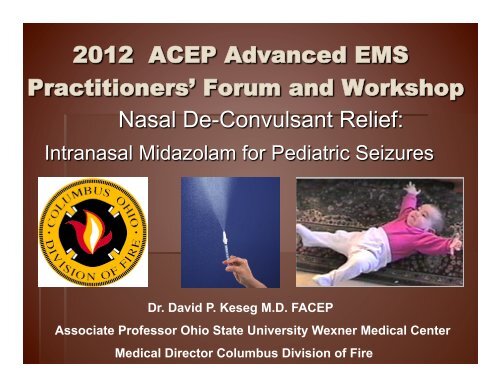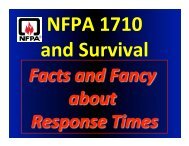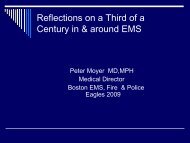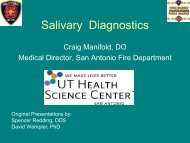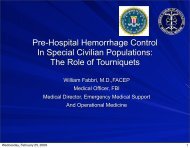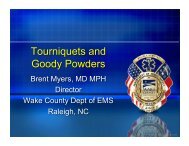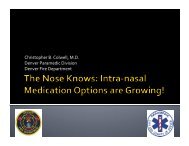Nasal De-Convulsant Relief: Intranasal Midazolam for Pediatric ...
Nasal De-Convulsant Relief: Intranasal Midazolam for Pediatric ...
Nasal De-Convulsant Relief: Intranasal Midazolam for Pediatric ...
You also want an ePaper? Increase the reach of your titles
YUMPU automatically turns print PDFs into web optimized ePapers that Google loves.
CFD EMS OVERVIEW
CFD EMS OVERVIEW• All ALS EMS System• Two EMT-Ps on each Medic Vehicle (32)• At least one EMT-P on each engine (34)• Engine/medic stations• Seven EMS Officers
Do you know Columbus???§ What was the name of the vehicle thatColumbus Fire <strong>De</strong>partment deployed in1969 to take care of cardiac patients?
IN <strong>Midazolam</strong>(<strong>Midazolam</strong>)<strong>for</strong> seizurecontrol§ There are an estimated 150,000 cases of statusepilepticus every year in the US.§ Morbidity and mortality are at least partiallydependent on the duration of seizure activity soseizures should be stopped as soon aspossible.§ IN delivery of benzodiazepines (midazolam orlorazepam) provides a very effective, safe andinexpensive means to rapidly achieve seizurecontrol.
Why <strong>Intranasal</strong>?
Which would YOU prefer?
Why <strong>Intranasal</strong>?The nose is a preferred access point <strong>for</strong>medication administration because:• Training is minimal• No shots are needed• It is virtually painless• It eliminates any risk of a needle stick
<strong>Nasal</strong> Mucosa§ The rich vascular plexus of the nasalcavity provides a direct route into theblood stream <strong>for</strong> medications that easilycross mucous membranes.
<strong>Nasal</strong> Mucosa§ The total surface area available in the nasal mucosa isestimated to be about 180 cm2 or (28 square inches)§ 10 cm2 is olfactory mucosa§ 170 cm2 is the richly vascularized respiratory mucosa.
Why <strong>Intranasal</strong>?§For many IN medications the rates of absorption and plasmaconcentrations are comparable to IV administration, and are typicallybetter than subcutaneous or intramuscular routes.
Nose brain pathway§ The olfactory mucosa is in direct contact withthe brain and CSF.§ Medications absorbed across the olfactorymucosa directly enter the brain.§ This area is termed the nose brain pathway andoffers a rapid, direct route <strong>for</strong> drug delivery tothe brain.
Tips on IN Administration§Always use amethod thatallows thedelivery of ameasured dose
Tips on IN Administration§ Use a method that fragments the medicationinto fine particles so the maximal nasalmucosal surface is covered and minimalvolume runs out the nose or into the throat
Tips on IN Administration§ Utilize both nostrils to double thesurface area <strong>for</strong> absorption and halvethe volume delivered per nostril
Tips on IN Administration§ Be knowledgeable of the “dead space”within the delivery device and account<strong>for</strong> this dead space when calculatingthe volume you will deliver to thepatient
KEY CONCEPTSMinimize volume, maximize concentration• 1/3 mL per nostril is ideal, 1 mL is maximum• Use the appropriately concentrated drug
KEY CONCEPTSBeware of abnormal mucosal characteristics• Mucous, blood and vasoconstrictors reduce absorption• Suction nostrils or consider alternate drug delivery method inthese situations
Mucosal Atomization <strong>De</strong>vice(<strong>Nasal</strong> <strong>De</strong>vice)§ <strong>De</strong>vice designed to allowemergency personnel todelivery nasal medicationsas an atomized spray.§ Broad 30-micron sprayensure excellent mucosalcoverage.§ Cost: $3.32 apiece
<strong>De</strong>vice<strong>Pediatric</strong> <strong>Nasal</strong>
<strong>Nasal</strong> Drug <strong>De</strong>livery inEMS: What Medications?§ Drugs of interest to EMS systems:§ <strong>Intranasal</strong> naloxone (Naloxone)§ <strong>Intranasal</strong> midazolam (<strong>Midazolam</strong>)§ <strong>Intranasal</strong> Fentanyl§ <strong>Intranasal</strong> Glucagon§ <strong>Intranasal</strong> Ketamine§ <strong>Intranasal</strong> Epinephrine§ Others
How To Use the <strong>Nasal</strong> <strong>De</strong>vice
<strong>Intranasal</strong> <strong>Midazolam</strong>effects in the field§ Why intranasal <strong>Midazolam</strong> <strong>for</strong> seizuresin the EMS setting?§ No needles§ No need <strong>for</strong> an IV in a seizing patient.§ Rapid delivery§ No delays in IV attempts.§ Socially acceptable§ No need <strong>for</strong> rectal drug administration.
But does intranasal<strong>Midazolam</strong> work in<strong>Pediatric</strong> seizures?
§ Seizures.<strong>Intranasal</strong> <strong>Midazolam</strong>Research Studies§ Lahat et al, BMJ, 2000.§ Prospective study: IN midazolam versus IV diazepam<strong>for</strong> prolonged seizures (>10 minutes) in children.§ Similar efficacy in stopping seizures (app. 90%).§ Time to seizure cessation:§ IV Diazepam: 8.0 minutes.§ IN <strong>Midazolam</strong>: 6.1 minutes.
<strong>Intranasal</strong> <strong>Midazolam</strong>Research Studies§ Seizures.§ Lahat et al, BMJ, 2000.§ Conclusions:§ IV diazepam and IN midazolam have similar efficacy atcontrolling prolonged seizures in children.§ IN midazolam controls seizures more rapidly becausethere is no delay in establishing an IV.
<strong>Pediatric</strong> NeurologyVolume 34, Issue 5 , Pages 355-359, May 2006
<strong>Intranasal</strong> <strong>Midazolam</strong>Research Studies• Rectal diazepam fails to abort about 40 percent ofseizures in randomized controlled trials. • (Lancet 1999;353:623; J Pediatr 1999;135:398; J Child Neurol2002;17:123.) • Several randomized trials now demonstrate thattransmucosal intranasal midazolam is as effective asintravenous diazepam and more effective than rectaldiazepam in aborting prolonged seizures. • (J Child Neurol 2002;17:123; Brit Med J 2000;321:83; Epilepsy Behav2004;5:253.) • In addition, its preference over rectal diazepam bycaregivers and its safety as home therapy have beenestablished in multiple small studies. • (Arch Dis Child 2004;89:50; J Paediatr Child Health 2004;40:556; Eur J PaediatrNeurol 1999;3:73; Seizure 2000;9:417.)
BOTTOM LINE:IN <strong>Midazolam</strong> as good and probably betterthan PR Diazepam in pediatric seizures
CFD <strong>Intranasal</strong> Drugs Given800<strong>Intranasal</strong> Drugs Administered 700600Axis Title500400300Nalozone<strong>Midazolam</strong>20010002008 2009 2010
IN <strong>Midazolam</strong> Indications140120100806040200820092010200
<strong>Pediatric</strong> seizure patients given <strong>Intranasal</strong> <strong>Midazolam</strong>YearNumber treated2008 102009 212010 212011 252012 14 (as of 8/2012)
Conversion Rate of pediatric seizurepatients given <strong>Intranasal</strong> <strong>Midazolam</strong>YearConversion Rate2008 50%2009 80%2010 64%2011 75%2012 72%(as of 8/2012)
NO HEAD TO HEAD COMPARISONWITH INTRANASAL MIDAZOLAM
IN <strong>Midazolam</strong> <strong>for</strong> seizure control
CFD Implementation of IN <strong>Midazolam</strong>§ Analysis of product: Jan-May 2003§ Recommendations <strong>Nasal</strong> <strong>De</strong>vice: June 2003§ <strong>Nasal</strong> <strong>De</strong>vice arrives: September 2003§ Training/Protocol development: Oct 2003§ Training completed: <strong>De</strong>cember 2003§ <strong>De</strong>vices deployed: Feb 2004
CFD Protocol <strong>for</strong> IN <strong>Midazolam</strong>§ For treatment of persistent seizure activity§ Procedure:§ Assess ABC’s – Airway, Breathing, Circulation§ For pulseless patients, proceed to ACLSguidelines§ Apply 100% oxygen NRB mask to seizingpatient§ Use age based table to determine propervolume of <strong>Midazolam</strong> <strong>for</strong> atomization:
IN <strong>Midazolam</strong> Dosing Table
Take away lessons <strong>for</strong> nasal midazolam:§ Dose and volume: Higher concentration required - use 5mg/mlIV solution.§ Dosing calculations are difficult: Use a predefined age or weightbased table to determine dose.§ <strong>De</strong>liver immediately on decision to treat: Atomize into nose with<strong>Nasal</strong> <strong>De</strong>vice, then begin standard care.§ Efficacy: No quite 100% effective so failures with nasal mayneed follow-up with IV therapy.
Survey on IN <strong>Midazolam</strong> use§ Distributed to all EMS personnel on medics§ 2 EMT-Ps/32 medics x 3 units = 192 total medicsreceived survey§ Two month response time given§ Oct-<strong>De</strong>c 2007§ Responses returned to EMS education§ 149 responses back: 77% return rate
Conclusions from survey on IN<strong>Midazolam</strong>§ IN <strong>Midazolam</strong> used most often <strong>for</strong> seizures (81%)§ IN <strong>Midazolam</strong> used 0 - 5 times per month (97%)§ 96% felt com<strong>for</strong>table with education on CPAP§ 3% felt uncom<strong>for</strong>table utilizing CPAP§ Patient remains unchanged or improves 99% of time§ 93% felt it somewhat or somewhat or greatly enhancedtheir practice
Naloxone
§ Questions??????????


